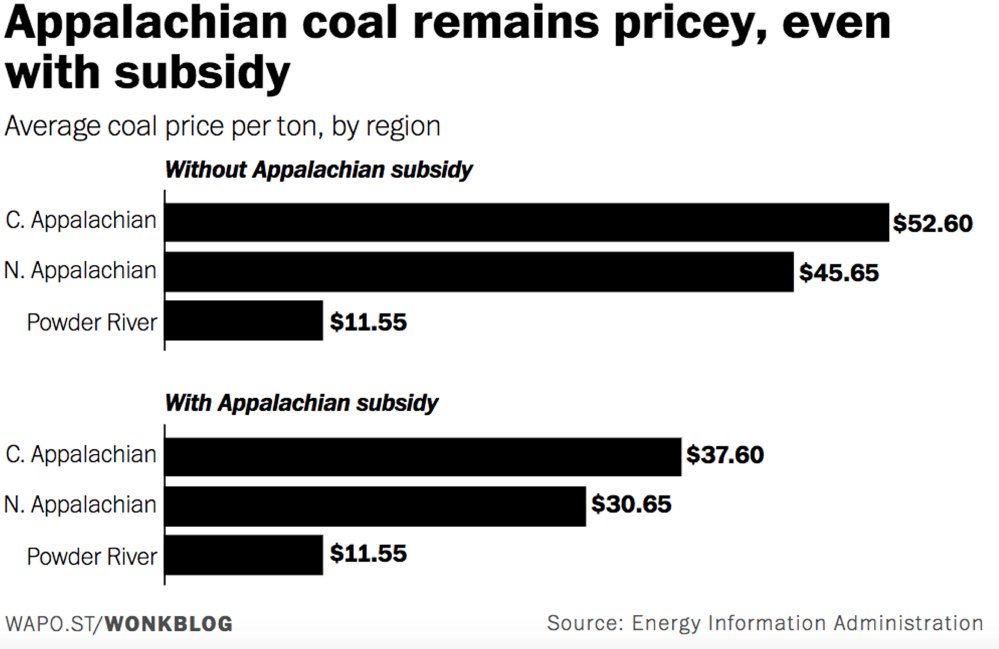West Virginia’s governor wants the U.S. to back the Appalachian coal industry with an annual $4.5 billion.
Jim Justice, the born-again Republican governor of West Virginia, is floating a federal proposal to bail out the struggling Appalachian coal industry at a cost to taxpayers of up to $4.5 billion a year.
As Justice described it to the Wall Street Journal, under the proposal the federal government would pay out $15 to Eastern power companies for every ton of Appalachian coal they purchase.
Justice is trying to sell the proposal as a “homeland security initiative” for protecting the Eastern energy grid. He told a West Virginia newspaper that “if you’re all on gas or you’re all on gas and Western coal and somebody puts a bomb at a gas junction point or somebody puts a bomb on a bridge coming from the West you could very well lose the entire Eastern power grid.”
Jason Bordoff, Director of the Center on Global Energy Policy at Columbia University, said “the claim that taxpayers should subsidize Appalachian coal for national security reasons is meritless.”
“Western coal production surpassed Eastern coal production two decades ago,” Bordoff said, “and Eastern coal has been in decline since the 1990s, but this has not led to grid reliability problems.”
He noted that “the U.S. has a well-developed and integrated energy infrastructure and rail network as well as storage system, and in the event of temporary disruptions, supplies could be rerouted and stocks drawn.”
The money in Justice’s proposal would be used exclusively to prop up the northern and central Appalachian coal production regions, which include parts of Pennsylvania, Ohio, Kentucky, West Virginia and far western Maryland.
Together those regions account for less than 25 percent of total domestic coal production, according to the Energy Information Administration. The remaining 75 percent of the domestic coal industry would receive no bailout.
Appalachian coal is struggling primarily because it is currently between four and five times more expensive to produce than coal from the Powder River Basin in Wyoming and Montana, which now accounts for over 40 percent of the nation’s production.
Powder River coal seams are much closer to the surface than they are in the Appalachians, making them easier and cheaper to mine. Many of them are on federal lands, which are cheaply leased to coal companies, driving prices down further. It also contains significantly less of the air pollutant sulfur than Appalachian coal, making it more desirable from an environmental standpoint.
As a result, the price differential between Western and Eastern coal is so extreme that even with a $15/ton subsidy, Appalachian coal would remain roughly three times more expensive than Powder River coal.
“We very much think it’s best when the government’s not involved, and feel the free market instead should be allowed to work,” the executive director of the Wyoming Mining Association told the Wall Street Journal.
“Concerns about fuel supply reliability are legitimate, but picking winners by subsidizing production in the name of national security of one fuel that is declining due to market forces is not a smart or cost-effective solution,” Columbia’s Jason Bordoff said.
But Justice told Bloomberg News that he’s found a receptive audience for the proposal in President Trump. “He’s really interested. He likes the idea,” Justice said.
Send questions/comments to the editors.



Success. Please wait for the page to reload. If the page does not reload within 5 seconds, please refresh the page.
Enter your email and password to access comments.
Hi, to comment on stories you must . This profile is in addition to your subscription and website login.
Already have a commenting profile? .
Invalid username/password.
Please check your email to confirm and complete your registration.
Only subscribers are eligible to post comments. Please subscribe or login first for digital access. Here’s why.
Use the form below to reset your password. When you've submitted your account email, we will send an email with a reset code.